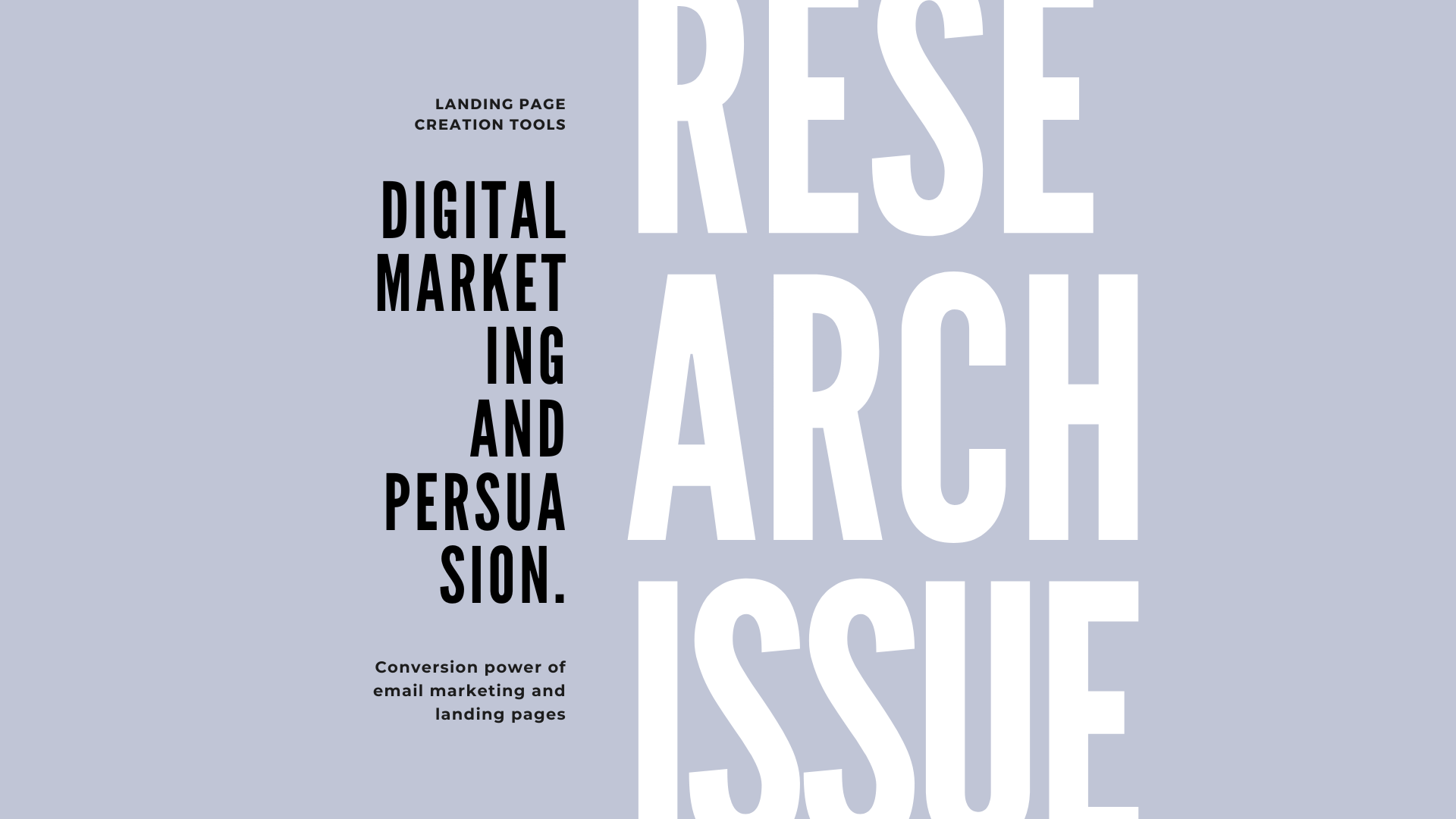Each of these elements is associated with different persuasive factors. Thus, an element such as the Unique Selling Proposition, through a main headline supported by a subtitle or secondary message, is intended to project commitment and coherence and to create trust, one of the key factors of persuasion. The image of the Hero, which is the first visual element of the page, is based on physical attractiveness, which is one of the factors that most moves the attitude and generates an affective inclination. Similarly, the Benefits are always focused on positive aspects that, in addition to physical attractiveness, generate an affective inclination that we call sympathy.
When digital marketing is mentioned, it usually refers to "the range of digital media, technologies and platforms used to reach and interact with consumers and businesses" [1]. All this, of course, implies an extensive online presence through controlled content on websites, social networks or ads, and uncontrolled content such as online reviews. However, within this wide range of media, two stand out due to their large distribution capacity and conversion power: email marketing and the landing page.
In our view, the two tools complement each other, so much so that some email marketing platforms have integrated landing page creation tools. To understand why, we need to keep in mind that landing pages have the task of attracting leads at the beginning of the funnel of a campaign, but also of converting them at the end. The main function of emails is to nurture and engage customers. Despite this peculiarity, there is a tendency to synthesize these two marketing tools, resulting in an HTML email whose structure mimics that of landing pages, creating an email that also performs the function of structuring and conversion.
The structure of the landing page
To better understand this statement, we must keep in mind that unlike other pages, the landing page is a standalone page that serves to market a single product. Nevertheless, there are cases when the landing page and the homepage coincide, such as Netflix. However, they usually differ in their focus on a single call to action rather than multiple ones, as is the case with the homepage, whose goal is to encourage navigation through different pages.
In this sense, landing pages as a marketing element are governed by a persuasive discourse whose essence is deeply psychological and whose structure is therefore based on seven elements [2] inherent to the principles of persuasion [3]:
1. The Unique Selling Proposition (USP):
2. Hero
3. Profits
4. Social proof
5. The Authority Principle
6. The Simplicity Principle
7. CTA
On a landing page, the elements of the Unique Selling Proposition usually coincide with the Hero, as shown in the image below. However, the other elements may vary depending on the purpose of the design and the intentions of the designer, as it is not a hierarchical structure.

Each of these elements is associated with different persuasive factors. Thus, an element such as the Unique Selling Proposition, through a main headline supported by a subtitle or secondary message, is intended to project commitment and coherence and to create trust, one of the key factors of persuasion. The image of the Hero, which is the first visual element of the page, is based on physical attractiveness, which is one of the factors that most moves the attitude and generates an affective inclination. Similarly, the Benefits are always focused on positive aspects that, in addition to physical attractiveness, generate an affective inclination that we call sympathy.
On the other hand, an element such as social proof is in itself a persuasive factor based on testimonials of satisfied customers who influence through their positive opinions, while the call to action is a persuasive factor based on reciprocity through short phrases such as "start for free download", or "get 50% off the purchase" which stimulate a specific action [4]. For this reason, they are more than a button or a link, because through them the exchange between user and provider takes place.
Other elements of the landing page are in themselves persuasive, such as the criterion of authority, which is based on the opinion of personalities or recognized brands, taking advantage of the fact that we are likely to be persuaded by representative figures or authorities, as Milgram [5] showed in his studies on obedience.

As we have already explained, the landing page is a complex unit, because the psychological foundations that underlie it must be manifested in a graphic interface designed to take full advantage of these foundations through essential structural elements such as the Unique Selling Proposition (USP), the Hero, the Benefits, the CTA or social proof, and the Authority Principle, the last two being specific to e-commerce [6].
Email marketing
From a business point of view, email is a functional marketing strategy that shows a rational way to operate in such an uncertain environment as that of sales. Its goal is to gain advantage over opponents who are also trying to convince potential customers to voluntarily subscribe to a list, stay on it, or perform a specific action.
However, from an operational point of view, email is a communication application related to the genre of letters, from which it inherited its three-part structure: Header, Body and Closing. The difference lies in the brevity and in some peculiarities in the designation of its elements, because due to its structure, in the case of the email it would be more appropriate to speak of Footer instead of Closing, so we have a structure of:
- Header
- Body
- Footer

Within this overall structure, the Header refers to the lines in the top section where the "subject," "sender," and "date" of the message are indicated. In email marketing, the first two lines are of great importance because they are subject to the regulations of CAN-SPAN [7], so poor wording in any of these lines will result in a spam rating. To avoid this, these lines must reflect a high level of predictability, legitimacy, and integrity.

In the body of the email, on the other hand, the content is expressed through introductory paragraphs that clearly state the main idea and supporting paragraphs that serve as arguments and justify that main idea. In many cases, these paragraphs are summarized in very specific lines that concisely express the message. To this compendium of paragraphs, the closing line of no more than two words, the signature lines, and the postscript are added resulting in a very short, concise, and direct message. In HTML format, the body of the email is structured differently, as the text content is supplemented with images, videos, links and calls to action, which is closer to the structure of a web page.

For its part, the Footer, as in the landing page or a web page, is an element located at the bottom of the page that contains copyright, contact and legal information, as well as some links to the main areas of the website. In email marketing, the footer is usually much more synthetic than that of a web page. In many cases it is limited to information about address, social networks, privacy, copyright and the possibility to unsubscribe or opt out.

Now, there are generally three main categories of emails based on the sales funnel [8]: acquisition, nourishment, and conversion, with the discourse changing depending on the objective of each spiral. For example, in the acquisition funnel, proactive and stimulating discourse predominates, tempered by more subtle invitational formulas, while in the nourishment funnel, the discourse shifts to the sympathetic and submissive through greetings, generous expressions, and friendly requests. Finally, in the conversion funnel, alarm and urgency semantics and an imperative tone predominate.
The relationship between the HTML email and the landing page
As we have already mentioned, the text content of the email in HTML format is supplemented with images, videos, links and calls to action, which resembles the structure of a website or, more precisely, a landing page. The reason for this similarity lies in the fact that both the landing page and the HTML email are based on a persuasive discourse, which, as we mentioned previously, uses psychological aspects such as likability through physical attractiveness and association with positive aspects, as well as social proof and authority criteria, all with the sole purpose of convincing a user to perform an action.
This statement is supported by the results of our previous studies, in which we analyzed a corpus of 60 landing pages from the SaaS, e-commerce, and Services industries and a corpus of more than 60 HTML marketing emails. The intersection of both analyzes revealed a correlation between the structure of the landing page and the structure of the email marketing body, whose common factor is persuasive discourse, which, according to Cialdini, is based on psychological aspects such as trust, sympathy, social proof, the principle of authority, the feeling of scarcity and reciprocity. These are aspects that are reflected in each of the seven structural elements that seem to be common to both marketing tools, as we pointed out when describing the structure of the landing page.

In principle, the two marketing tools do not differ significantly in their underlying structure, as the figure above shows. So, is it an exact structure common to landing page and email marketing? The evidence suggests that there are important variations in the vast majority of our sample that suggest a more synthetic structure in the case of email marketing, a fact that would allow us to distinguish the structure of one tool from the other, which, while based on persuasive targeting, uses or omits certain elements in each case.
In this sense, elements such as the USP, the Hero, the CTA or the Benefits can be considered essential to the structure of email marketing, since their frequency ranges from 60% to 100% of the total sample. However, according to our previous studies [9], these elements are also essential on the landing page, as shown by the contrast of the graphs below, which reflects the frequency of the elements in the case of both tools.

Up to this point, there are more similarities than differences, but this contrast also shows a different behavior of frequency for elements such as social proof, the Authority and Simplicity Principles where the frequency ranges from 3% to 10%, maximum 15%. This fact suggests that these elements have almost no relevance in the case of email marketing, so the structure of email marketing is mainly based on four aspects: the USP, the hero, the Benefit and the CTA . If we take this fact into account, we could say that email marketing can also be defined as a persuasion tool focused on conveying trust, friendliness and reciprocity.

This scheme is repeated throughout our sample. Note, however, that one element of this structure, such as Benefits, is concentrated primarily in the Conversion Funnel, so unlike the other Funnels, the structure of the Conversion emails has the distinction of having an unusual element in the Acquisition and Nutrition emails, as you can see in the image below.

This detail tells us that we are dealing with two email marketing structures, one of which consists of only three common elements for the acquisition and nutrition funnel emails, and that it is composed of:
- USP
- The Hero
- The CTA.
The other structure consists of these three elements and an additional element that is common for emails in the conversion funnel. The additional element in this case is the benefit, so the structure for this funnel should be as follows:
- USP
- The Hero
- The Benefit
- The CTA
The following image illustrates in a didactic way the difference between an acquisition email marketing and a conversion email marketing. You can clearly see that in the acquisition email on the left, only three elements are activated, namely USP, hero and CTA, while in the conversion email on the right, four elements are activated: USP, Hero, Benefits and CTAs.

Of course, this does not mean that the benefits will never appear in a nutrition email or that they will stop appearing in a conversion email; this is indeed possible, although the probability is very low according to our data. Other elements such as the principle of scarcity or social proof may also occur, but according to our data this is very unlikely. This panorama shows us a structure composed of only four elements, whose main objective is three things: To generate trust, sympathy, and reciprocity in the user.
Conclusions
At first glance, both landing page and HTML email marketing have similar characteristics. It could be said that both marketing tools are based on a persuasive approach that has psychological aspects such as trust, friendliness, the criterion of authority, simplicity , and reciprocity.
These aspects are manifested in the graphic interface through seven structural elements that we have identified in previous studies for the landing page, but which obviously apply to email marketing as well. At this point, we ask ourselves whether the landing page and email marketing share a common structure or whether each tool has its own structure. To answer this question, we conducted a comparative study based on the frequency of the two marketing tools. It is based on the structure of the seven elements we previously identified for the landing page, namely: the USP, the Hero, the Benefits, the Social Proof, the Authority Principle, the Simplicity Principle, and the CTA. The results led us to conclude that:
- The low frequency of structural elements such as Social Proof, the Authority Principle and the Simplicity Principle leads them to be considered irrelevant in the case of email marketing.
- The structure of email marketing is largely based on four aspects: the USP, the Hero, the Benefits and the CTA.
- Based on the psychological background of persuasion, we can say that email marketing can also be defined as a persuasive tool focused on conveying trust, sympathy and reciprocity.
- The Benefits element is typical of the structure of conversion emails, as opposed to acquisition and nurturing emails.
- We are dealing here with two email marketing structures: one consisting of only three elements (USP, Hero, CTA) typical of acquisition and nurture funnel emails, and another consisting of these three elements plus the Benefits element typical of emails. of the conversion funnel, where the structure of this funnel would consist of: the USP, the Hero, the Benefits and the CTA.
- The structure of the email marketing starts from the same configuration as that of the landing page, but it consists of only four elements and not seven as in the case of the landing page.
References
[1] Chaffey, D. and Smith P. (2017). Digital Marketing Excellence. Routledge. London and New York.
[2] Rojas, N. (2021). The landing page: technology and persuasion. Recovered https://www.quo.agency/insights/the-landing-page-technology-and-persuasion.
[3] Cialdini, R. B. (2001). Influence: Science and practice (4th ed.). Boston: Allyn & Bacon.
[4] Unbounce. (n.d. -b). What is a Call to Action? Recovered https://unbounce.com/landing-page-articles/what-is-a-cta/.
[5] Milgram, S. “Behavorial Study of Obedience.” Journal of Abnormal and Social Psychology 67 (1963): 371–7.
[6] Rojas, N. (2021).
[7] Controlling Assault of Non Solicited Pornography and Marketing Act of 2003.
[8] Gunelius, S. (2018). Ultimate Guide to Email Marketing for Business. Entrepreneur Press.
[9] Rojas, N. (2021).





